We encounter unusual plants from time to time. Here are several (thanks
to Mike Mancuso for showing us the first four plants ) along with various
miscellaneous plants.
 |
English sundew, Drosera anglica
Huds. (left) The English sundew
is a circumboreal plant that ranges across northern North America and Eurasia..
Unlike other sundews, ours is a tiny plant whose leaves measure no more than
a quarter of an inch in length. They are covered with small projecting stalks
that exude a clear sticky substance that ensnares insects--this is a carniverous
plant. It has a small white flower (not present in this image) Sundews are
wetlands plant.
Bog St. John's-wort, Hypericum anagalloides
Cham. & Schlect. (right)This tiny bog
plant, formerly classified in family Hypercaceae and now in the Clusiaceae
family. It is a native plant unlike the far larger, common St. John's-wort,
a major pest, considered a noxious plant in many states. Ours stands only
an inch or so tall and is identified by its boggy environment and by its
yellow flower which closely resembles that of the common St. John's-wort,
although far smaller.
Both of these plants were photographed in Central Idaho's Bull Trout
Bog..
|
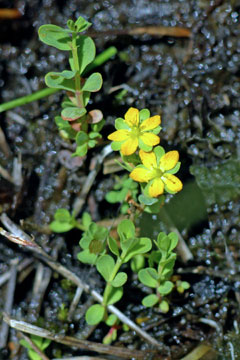 |
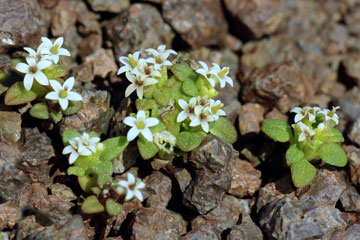 |
Dimeresia, Dimeresia howellii
Gray. (left) The dimeresia grows in small scattered
clumps on the dry rocky soil of foothills and low mountains. Few would guess
that the dimeresia is in the aster, or composite, family. Although difficult
to see without magnification, its flowers--barely 1/4" across--consist of
an involucre made up of spreading white bracts which contain a tiny
apetalous discoid flowerhead made up of several tiny florets. It is
found on the Owyhee highlands in Idaho, and adjacent Oregon, into northern
Nevada and northern California. This is the only species in
its genus.
Desert prince's plume, Stanleya pinnata
(Pursh) Britton (right). As the common name suggests,
the prince's plume grows on dry ground. It is found in western states from
southern Oregon and California, east to the Dakotas, Nebraska, Kansas and
Texas. It is tall and attractive so it is sometimes used in xeric situations
as an ornamental. The leaves are said to be edible, and if sampled will be
found to have a pronounced "cabbage-y" taste. The stanleya (named for Lord
Edward Stanley, a British ornithologist) is in the mustard family (Brassicaceae).
|
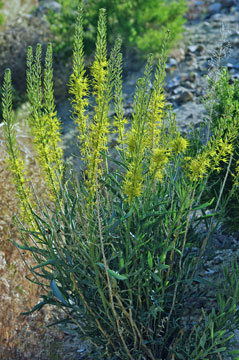 |
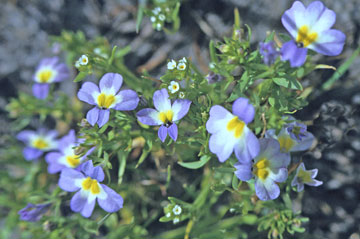 |
Porterella, Porterella
carnulosa (Hook & Arn.)
Torr. is another semi-aquatic plant that grows
on mud, in marshes, or on the edge of ponds. It is in the bell-flower family
and is quite similar in appearance to two other genera, Downingia
and Lobelia, that also grow in Idaho. These plants have upside-down
(("resupinate") flowers because--as with some of our orchids--the upper
lip (three parted in this plant) is twisted to become the lower lip.
Broad leaf cattail, Typha
latifolia
L. is in the small Typhaceae.family It is a ubiquitous,
useful, water plant that spreads by seed and by extensive rhizomes. It is
found in all of the American states and Canadian provinces. The plants
effectively remove contaminnts from slow-flowing water, serve as shelter
for water and other birds, and its rhizomes and fruiting parts were used
as food by native Americans. The upper pollen-bearing "flowers" merge with
the lower brown pistillate flowers on a tall pithy stem. A fruiting plant
is shown behind. A similar imported plant, Typha angustifolia, is
also common but less widely distributed. It may be distinguished from the
broad leaf species because the staminate and pistillate segments are separated
on the stem. |
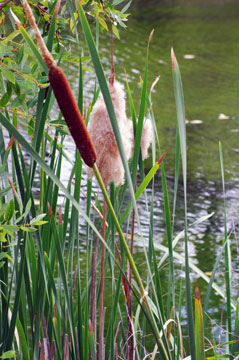 |
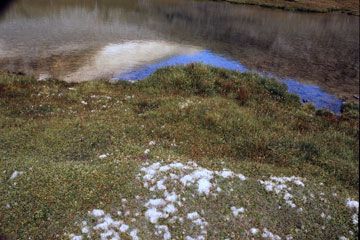 |
Arctic willow, Salix
arctica Pallas.
Although it may grow above treeline in other places in
Idaho, we have only seen the arctic willow high in the Hyndman Basin in Central
Idaho's Pioneer Range. This alpine plant is prostrate lying on the
tundra on which it grows. Protruding ripe catkins are surrounded by cotton
like accumulations of filaments and their attached seeds, forming small
windrows. |
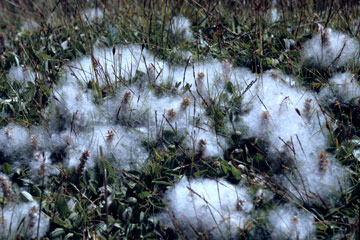 |
 |
Puncture vine, or Mexican sandbur, Tribulus
terrestris L. (left) is a
nasty piece of work. While its leaves look like those in the pea family,
its 5-petaled flowers do not; it is , in fact, in the creosote bush family,
Zygophyllaceae. The spines on its fruiting body are as rigid as a thumb-tack
and really can cause punctures in thin walled-tires, especially those of
bicycles. The plants are found in every state, and are considered
--understandably--to be noxious weeds in many. Puncture vines do not, so
far as we know, grow at higher elevations. It's generic name,
Tribulus, is the Latin word for "caltrop," the three sided defensive
device scattered on the ground in ancient times to slow attacking men and
their horses.
Western (or yellow) skunk cabbage, Lysichiton
americanus Hulten & St. John is, like the
eastern skunk cabbage, a striking and somewhat similar plant. It lacks the
strong, skunk-like aroma of the eastern plant. Both are members of the Araceae
familyalthough in different genera. The western skunk cabbage grows
in the Pacific coastal states where it is common in boggy areas. It is
encountered less commonly further inland as far east as the Idaho
panhandle. It is certainly one of our more striking and attractive spring
plants. |
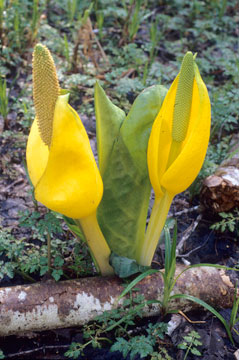 |
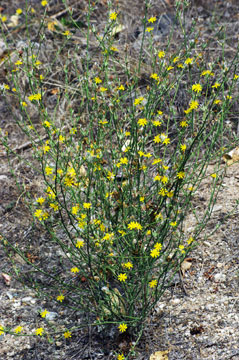 |
Willow-leaf lettuce, Lactuca
saligna L. (left, right) is
not listed by the USDA as being present in Idaho (although it is found
in nearby states). It is very much here, however, growing along the
Boise river and on nearby ground. The plants release vast numbers of seeds
in late summer (right), each borne aloft on their parachute like pappus,
efficiently spreading the weedy plant far and wide. Unlike the related weed,
Lactuca serriola
(both are European imports), the willow-leaf lettuce has not
yet found its way into our mountains. |
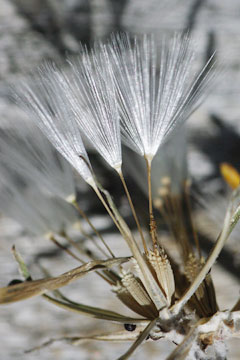 |
|
|
|











